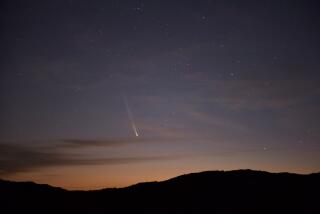New Comet Discovered by Halloween Sky-Watcher
- Share via
PALO ALTO — An amateur astronomer trying to photograph a distant nebula in the constellation Taurus got the treat of his life Halloween night when he spotted a new comet.
“It was around 2 a.m. and I was looking forward to going to bed, when I held up the negative and somewhat to my dismay, I saw what looked like a scratch,” said Bill Sorrells, vice president of the Peninsula Astronomical Society.
“I took a closer look and it actually was a fuzzy streak, characteristic of a comet. I thought it was almost certainly a comet, but I was trying not to get excited. The odds are it’s already a known comet you’ve blundered onto.”
But the comet was indeed unknown and now bears his name, having gotten the official seal of approval from the world’s comet clearinghouse, the Central Bureau for Astronomical Telegrams at the Smithsonian Astrophysical Observatory in Cambridge, Mass.
Sorrell, 30, was using the telescope at the Foothill College Observatory in Los Altos Hills when he spotted the shifting glow. After reporting it, the discovery was confirmed last week by astronomers in England, Canada and Japan.
“When you read the listings of known comets found over the years, like Halley’s, some of them have been discovered by the big names in the history of science,” Sorrells said. “To be among those names, not bigger or smaller, but just the same, is very rewarding.”
Sorrells is one of only three amateur astronomers who have discovered a comet since 1970, said Brian Marsden, director of the Central Bureau for Astronomical Telegrams, where between two and 12 new comets are reported annually.
“Usually the professionals, with their wide-field instruments, are pretty quick getting onto a comet like this on the dark part of the sky,” Marsden said. “It’s unusual that an amateur snapped up one like this.”
“The professional astronomers have other things to do than watch stars brighten and dim,” Sorrells said. “But the trench work of just plain observing is something amateurs can do and provide valuable data.”
Since the discovery, he has been driving to the observatory every night from his home in Pleasanton to take another peek at his high-flying namesake.
“It’s exciting, in a kind of esoteric way,” Sorrells said.
More to Read
Sign up for Essential California
The most important California stories and recommendations in your inbox every morning.
You may occasionally receive promotional content from the Los Angeles Times.













